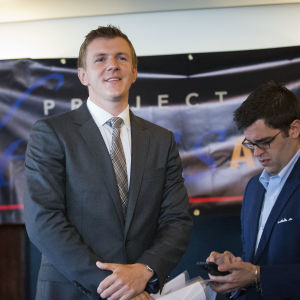The crowd at the bar was loud and the woman was beginning to dish and even slur her words. Finally, she blurted out just what the secret agent wanted to hear: that new education standards for students are a sham.
“In vino veritas,” (trans. “In wine, truth”) James O’Keefe, the activist who has risen to prominence with his undercover videos, acknowledged afterwards, giving insight into how he had snagged his latest prey.
Many likely assumed O’Keefe would be a one-hit wonder. His infamous hidden camera recordings of ACORN offices in 2009 suggested that the organization’s employees were encouraging criminal behavior. A few months later, the community organization shut down nationwide as Congress cut off government funding.
But O’Keefe was not done there. As he has traveled the country, his guerilla-style journalism has been used to go on the attack against National Public Radio, Hillary Clinton, and teachers unions. Along the way, his organization, Project Veritas, has relied on an arsenal of creative techniques to infiltrate targets.
But catching a subject who may have had a few too many drinks may mark a new threshold for the daring O’Keefe. And in the case of his latest investigation, it raises questions about the veracity of the information he obtained.
In videos released this week, O’Keefe’s agents spent months on a “full infiltration,” posing as lobbyists and befriending a textbook salesperson and a teacher to “expose how crony capitalism is taking over America’s educational system.”
The edited videos show the textbook salesperson, Dianne Barrow, state that she hates kids, and she asks: “You don’t think that the educational publishing companies are in it for education do you? No. They’re in it for the money.”
Barrow was fired by publishing company Houghton-Mifflin after the video was released, but she has told the media her comments were taken out of context and she was joking.
O’Keefe declined to release the full video to InsideSources. He explained that when he has released the raw footage for other sting operations, the mainstream media goes harsher on him without reason. He makes the case that TV and print journalists would never release their notebooks or give up their sources.
“Why am I being held to a higher standard than all the other award-winning journalists?” O’Keefe asks. “You have to ask all the other media the same question.”
The problem for O’Keefe is that his latest videos offer no new insight and contain no evidence against his supposed target: Common Core. Even if the raw footage were to show the interviewees’ comments were not taken out of context, it’s not clear how a low-level textbook saleswoman disliking children would provide any damaging new evidence in the debate over Common Core. Textbook companies only stay in business if they make a profit. That is also irrelevant in the debate over Common Core. There’s no evidence getting rid of Common Core would hurt textbook companies’ bottom lines.
What is clear from the latest videos is that O’Keefe’s operations have evolved from his early hidden camera recordings where his colleague, Hannah Giles, simply walked into an ACORN office pretending to be a prostitute and elicited responses from the low-level employees.
“You have to build relationships with people to get access to them,” O’Keefe told InsideSources. “We have built a full-scale investigative intelligence operation. We have a Navy SEAL as our field director. We have an Army sergeant as our researcher. We have people who have worked for the CIA building our aliases. And we have undercover people that are trained in the tactics of Saul Alinsky, Tom Wolfe, and spycraft. So it’s a very unique kind of operation. It’s, of course, investigative journalism. It’s a form of interviewing subjects and getting information. But we’ve turned it into a kind of intelligence operation.”
O’Keefe said they may be meeting with someone for six months before they get video tape that is worth publishing to their audience. They won’t tell a journalist these things, but they will tell their lobbyist friend with a self-interest.
“What we do here is we confirm suspicions. We show people what they already know to be the case, but we prove it. And whatever it takes, however deep we have to dig, whatever dark corner of some office we have to get access to—we will get there and expose it,” he says.
How does O’Keefe get the secret footage? Hidden cameras in ties, lapel pins, drones, pens, and goggles. There was one particularly effective hidden camera that O’Keefe wouldn’t disclose.
“We are basically a miniature version of the CIA,” said O’Keefe. He couldn’t provide much detail about their tactics because, “Our operations are classified” and “We have people in the field right now.”
But O’Keefe’s most successful tactic of all doesn’t quite have the glamour of James Bond-style spycraft. He acknowledges simply using alcohol to snag his prey. He boasts of one instance in particular with a teachers union official “getting plastered.”
Such tactics, however, raise questions. Dr. John C. Watson, an expert in journalism ethics at American University, explains that if a journalist is seeking to determine whether a person drinks a lot or drinks to excess, then it would be ethically reasonable to report based on that person being intoxicated. But if a journalist is seeking evidence of some other truth, it would clearly not be the best evidence. Building a case in journalism based on the interviewee’s intoxication “is clearly unethical,” says Watson.
Todd Gitlin, a journalism professor at Columbia University, simply states: “To liquor up your interviewees is indecent.”
The questions over his tactics are unlikely to stop O’Keefe who strongly defends them. But while in wine, there may be truth, in the person consuming the wine, there’s usually just confused thoughts, slurred words, and little to learn.

